Understanding All Pool Terms: A Comprehensive Guide
Are you sure that you understand all the pool terms? There are many more than you might expect. Pool, or billiards, is a skill-based game played in game rooms, pool halls, and bars worldwide.
However, even seasoned pros sometimes misunderstand terms used in pool games, not to mention pool slang. Hence, knowing how to refer to specific terminology and areas of the table can help you avoid unwanted mistakes and keep the pool rules straight.
No worries. Pearson Cues has researched this guide to help you understand the most critical billiards terms and phrases to get right into action.
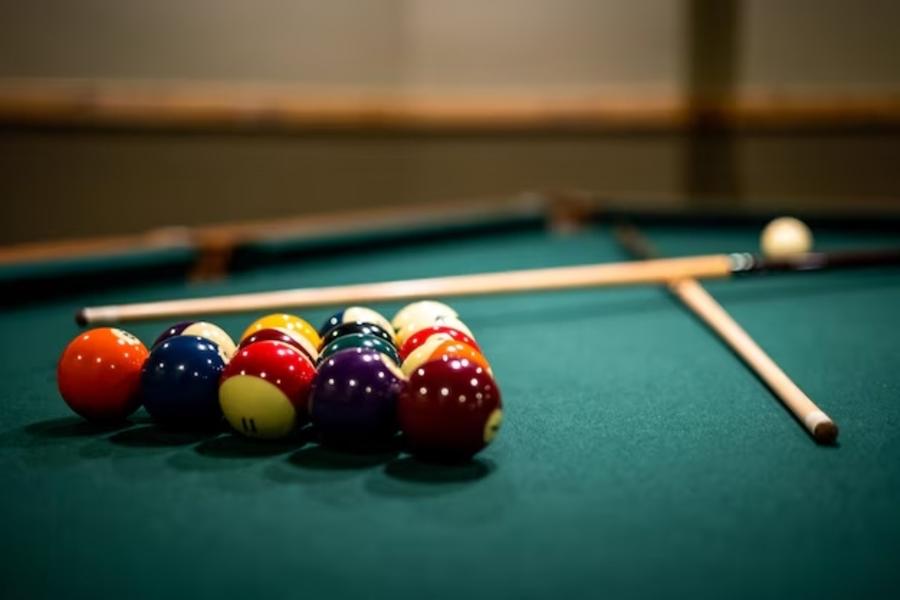
Pool Terms and Billiard Terminology
As a beginner, you may want to ask what is the white ball called in a pool. You’re not alone! Pearson Cue will explain this basic term below:
- 8-Ball: A popular pool game played with 15 numbered object balls (7 solid-colored balls, 7 striped balls, and the black 8-ball) and a cue ball. Players aim to pocket their designated group of balls (either solids or stripes) and then legally pocket the 8-ball to win the game.
- 9-Ball: Another popular pool game with 9 numbered balls (1 through 9) and a cue ball. Players must pocket the balls numerically, with the 9-ball as the last to be pocketed to win the game.
- Cue Stick: Also known simply as a “cue,” it’s the long, tapered stick players use to strike the cue ball and make shots.
- Chalk: Before each shot, a small cube of chalk-like substance is placed on the tip of the pool cue stick to increase friction between the cue ball and tip, reducing the chance of a miscue.
- Cue Ball: The white ball players strike with the cue stick to hit other balls on the table. Pool players use it to make shots and maneuver other balls around the table.
- Object Ball: Any numbered balls (excluding the cue ball) that players aim to pocket during a game. In 8-ball and 9-ball, these are the balls numbered 1 through 15.
- Solid and Stripes: In 8-ball, people divide the object balls into two groups: solids (1 through 7) and stripes (9 through 15). Players are assigned one of these groups, and they must legally pocket all of their designated group’s balls before attempting to pocket the 8-ball.
- Bridge: Also known as a “cue bridge” or “rest,” a bridge is a support used to steady the cue stick for shots too far for a normal hand bridge. You can form it with your hand, or players can use a mechanical bridge if available. The player who pockets the ball is assigned that type depending on the first-pocketed type.
- Rack: A triangle-shaped device used to arrange the balls in a tight formation at the beginning of a game. The balls are placed in the rack before each game to ensure a fair and consistent starting position.
- Scratch: When the cue ball is pocketed or leaves the table during a shot, it’s considered a foul called a “scratch.” In most games, this results in a penalty for the offending player, typically allowing the opponent to place the cue ball anywhere on the table.
- Pocket a Ball: To legally sink a ball into one of the table’s pockets, scoring points or fulfilling the game’s requirements, such as in 8-ball or 9-ball, where players must pocket their designated group of balls to win.
For further understanding, you can see how each element put in a table in the image below:
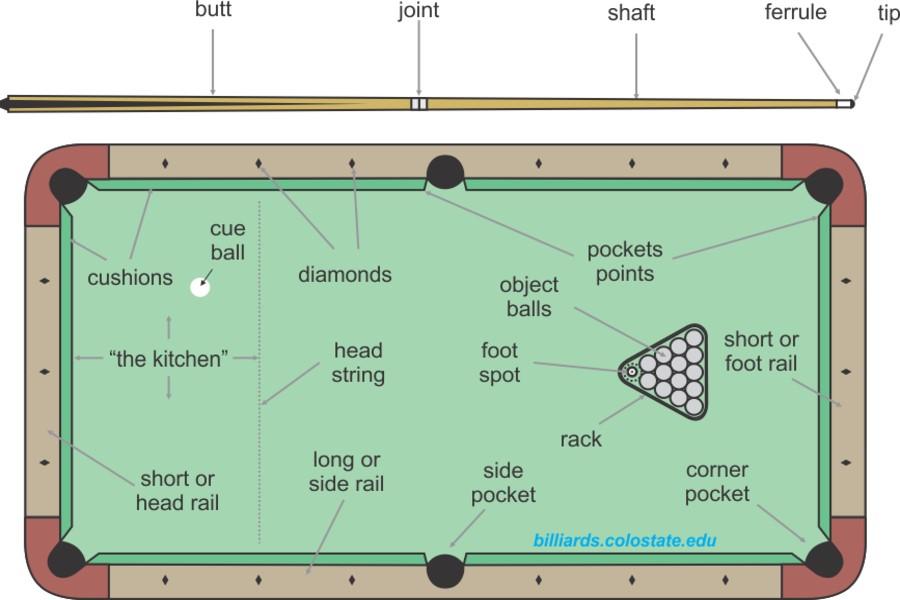
Parts of a Pool or Billiards Table (300-400w)
After knowing what pool balls are called, we will now move to another part relating to the billiards table. There are many terms in the billiards table you must know before giving a shoot:
- Cushions: Also known as rails, cushions are the padded borders that surround the table’s playing surface. They are typically made of rubber and covered with cloth. The cue ball can rebound in different directions when it strikes the cushions.
- Long Rails: The two longer sides of the table with the attached cushions. Shots that involve banking or rebounding off the long rails are common in many pool games.
- Short Rails: The two shorter sides of the table with the attached cushions. Players often use them as reference points for positioning shots.
- Foot Rail: The end of the table where the balls are racked in the opening break. In most pool games, the foot rail is where the 1-ball is placed in the rack.
- Head Rail: The opposite end of the table from the foot rail. In games like 8-ball and 9-ball, the headrail is where the 8-ball or 9-ball is typically placed in the rack.
- Pockets: The openings around the table’s perimeter where balls are pocketed. A standard pool table typically has six pockets: one at each corner and one in the middle of each long rail.
- Sights: Also known as diamonds or markers, these are usually small, decorative marks along the rails used as aiming references for bank shots. They help players visualize the angles needed to make precise shots.
- Strings: Imaginary lines extending from the points where the side pockets meet the long rails to the corresponding points where the long rails meet the head and foot rails. These lines help players visualize and plan their shots more accurately.
- Spots: Small markings on the table surface, typically used in games like snooker and occasionally in the pool. They denote specific positions on the table, such as where the cue ball is placed after a scratch or where the pink ball is racked in snooker.
The image below will illustrate clearly about each part of a billiard table:
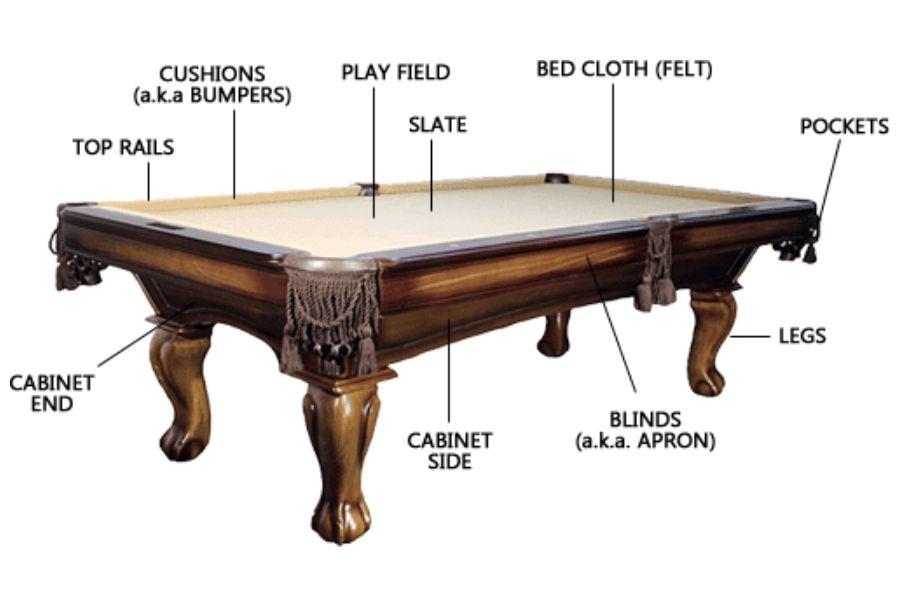
Miscellaneous Pool Terminology
The next billiards terminology will be how to describe a shot. In a pool game, you may shoot with various strategies. So, how can you name each shot? Below is the guide:
- Backspin: Also known as “draw” or “bottom spin,” backspin is a type of spin applied to the cue ball by striking it below its center. This causes the cue ball to spin backward after contact with a cushion or object ball, often used to control the cue ball’s position for the next shot.
- Call Shot: A rule in many pool games where players must specify which ball to pocket and how they intend to do it before taking a shot. If the player successfully pockets the called ball using the intended method, they continue their turn. If they fail to do so, it’s typically a foul, and the opponent gains control of the table.
- Break Shot: The opening shot of a game where the player strikes the racked balls with the cue ball, aiming to spread them across the table and begin gameplay. The break shot is crucial in setting up the subsequent shots and gaining an advantage in the game.
- Breakout Shot: A shot aimed at separating clustered balls, typically done to open up a pocket or create opportunities for subsequent shots. Breakout shots are strategic maneuvers used to gain control of the table and improve a player’s position.
- Bank Shot: A shot in which the cue ball rebounds off one or more cushions (rails) before striking an object ball. Pool players often use bank shots to pocket balls that cannot be directly targeted or to position the cue ball for the next shot.
- Jump Shot: This shot involves lifting the cue ball off the table surface, usually by striking it sharply downward with the cue stick. This causes the cue ball to hop over obstacles (such as other balls) before making contact with the intended target ball. Jump shots are typically employed when other balls obstruct the cue ball or when precise positioning is required.
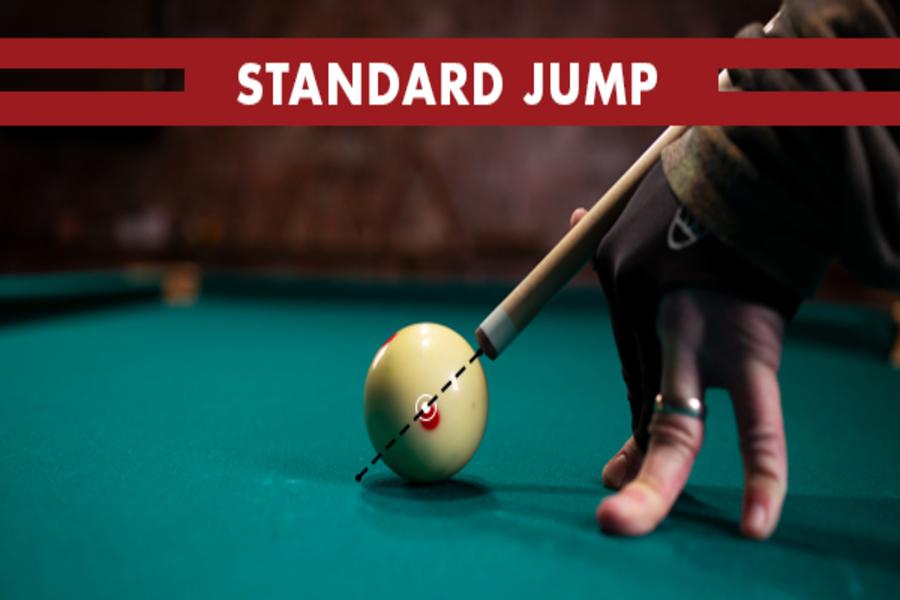
See More: How To Play Pool In Four Steps? (Expert Guide)
Conclusion
If you want to truly enjoy and excel at pool and billiards, it’s important to understand the specific pool terms used in the game. These pool table terms offer insight into the strategies and skills required to play well, from the initial break shot to the tricky jump shot.
Let’s rack your pool cue and start your game now!
Frequently Asked Questions
- What are the names of pool shots?
There are many pool shots, each with a name reflecting its purpose or execution. For examples:
- Draw Shot: Players hit the cue ball with a backspin to slow it down after hitting the object ball.
- Follow Shot: Players shoot the cue ball with forward spin to make it travel further after hitting the object ball.
- Straight shot: Players hit the cue ball directly in the center and aim it in a straight line toward the object ball and the pocket. The goal is for the cue ball to travel in a straight path, hit the object ball head-on, and send it into the intended pocket.
- Bank Shot: This type of shot in billiards is similar to a straight shot, where the aim is to hit the cue ball directly in the center. However, the objective of the bank shot is to shoot the ball into the object ball so that it hits a rail and bounces off it to land in a pocket eventually.
- Plant Shot: Players hit the cue ball to make it contact another object ball first, then hit the target object ball.
- Jump Shot: Players shoot the cue ball with enough force to lift it slightly off the table to clear object balls in front of it.
- What is the first shot called in the pool?
In pool terminology, the first shot, specifically in games like 8-ball and 9-ball, is called the break shot. The break shot involves shooting the cue ball from the head of the table (the end with the cue ball starting area) towards the rack of object balls.
The goal is to scatter the balls effectively, ideally pocketing one or more object balls and positioning the remaining balls for your advantage throughout the game.
- What is the proper term for the pool?
In billiard terms, “pool” is appropriate for the game played on a table with pockets and numbered balls. “Billiards” is a broader term that includes several cue sports, including pool. Pool tables are a type of billiard table, but not all billiard tables are pool tables.
Therefore, both “pool” and “billiards” are technically correct, but “pool” is the more specific and commonly used term.
- What is a pool stick called?
Cue sticks, also known as billiards cues, pool cues, or snooker cues, are necessary equipment for playing pool, snooker, and carom billiards. They are used to hit the cue ball and other balls during the game.
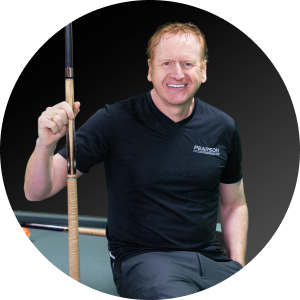
Dave Pearson
Dave Pearson, the world's leading pool entertainer, is renowned globally as the ultimate exhibition player.
Boasting 20 world records endorsed by the prestigious Guinness Book of World Records, Dave established a legendary history in the sport industry.
